Wireless
MWC 2024 Buzz Signals Continuing Momentum for 5G and Other Mobile Technologies
Key Points
- Hot topics at MWC 2024 in Barcelona included 5G, Network as a Service (NaaS), AI, Open RAN and more.
- Although there were fewer announcements about disruptive, new 5G technologies than in recent years, activity during MWC suggested overall forward movement is continuing in the development of 5G solutions.
Mobile World Congress (MWC) is the flagship conference for the mobile industry, where vendors and mobile operators showcase new products, technologies and solutions. The buzz at the annual trade show translates to the pulse of the mobile industry and offers a sneak peek at its direction.
This year at MWC Barcelona, more than 100,000 participants attended from 200-plus countries, and more than 2,700 small and large vendors and operators were on exhibit across eight halls. The level of activity at the event was on par with pre-pandemic levels.
Here are a few general observations and themes from this year’s MWC.
‘Show Me the Money’
Every year, there is huge anticipation for announcements about disruptive technologies or new solutions in the mobile industry. This year, the impact of new developments and disruptive 5G solutions was muted compared with years past — somewhat expected, as operators are still undergoing 4G-to-5G network transitions, awaiting releases to complete their fully featured 5G networks.
Operators who haven’t yet seen the expected monetization from their 5G build-outs are cautious about upcoming investments toward continuing the rollout of the network. Overall, a limited number of solutions showcased at the show could be categorized as “money-making” for operators.
However, the news wasn’t all negative! Vendors and operators demonstrating Network as a Service (NaaS) solutions were pretty common. CableLabs even presented a demonstration illustrating potential applications of NaaS on the fixed network.
In addition, the event partner co-located with the MWC — “4 Years From Now” (4YFN) — had its largest-ever showing, with start-up and venture-capital companies coming together to showcase the state of what’s possible with 5G networks. This was a very popular part of the show.
AI Will Enhance Efficiencies in 5G
Artificial intelligence (AI) was a common theme among 5G vendors and operators demonstrating efficiencies in 5G service delivery, throughput, operations and performance. However, nothing was truly disruptive.
The AI solutions were focused on operator-specific network improvements to squeeze out 5G network performance, using AI to improve their return on investment (ROI) in place of spending on additional 5G network rollout.
In addition, AI was generally tailored to vendor-operator partnerships for specific 5G network improvements and use cases using prototype solutions still under development. Overall, the role of AI in 5G networks was a hot topic, but there were no clear answers to questions about how the technology might ultimately impact the industry.
Network Virtualization and Disaggregation Continues to Advance
Network operators and vendors continue to disaggregate network components and virtualize network functions as shown by many advanced solutions on exhibit for the 5G core and RAN. This includes both operator-based on-premises virtualization along with cloud-based services from third-party service providers. This shows the continuing network evolution toward virtualization, providing new services, reducing costs and enhancing operational efficiencies.
6G Still in Early Stages
There was little 6G activity. Most of the 6G activity was centered around test equipment to help enable and develop ideas and proof of concepts. With 5G still being deployed and a few years from its full features, it seems that 6G is in the early stages of ideation in the academic, vendor development and standards community.
Open RAN Continues to Gain Momentum
Open RAN vendors showcased further evolution of disaggregated and virtualized RAN solutions, featuring more capabilities and more availability of common uses that include macro cells, small cells, fixed-wireless access (FWA) and private networks. Improved functionality included higher-level MIMO RU solutions such as 32×32 and 64×64 MIMO in the mid-band.
There was also advancement in RAN Intelligent Controller (RIC) and Service Management and Orchestration (SMO) platforms, with various Open RAN partnerships showcasing capabilities closer to commercial operation. Again, in many cases, these advances were specific to operator and vendor partnerships, so Open RAN via the O-RAN Alliance has a ways to go before realizing its final vision.
Other Hot Topics
Other topics discussed at the show included the following:
- The Internet of Things (IOT) remains a potential key trend for 5G networks. Vendors and operators alike showcased many use cases and product solutions.
- The use of non-terrestrial networks (NTNs) for mobile communications is starting to make progress. Advances in satellite technology are making the technology a viable option for traditional voice communications in unserved rural areas and as a backup alternative during network outages.
- Energy efficiency and sustainability continue to be top of mind for operators. Most vendors are providing solutions to help drive down energy consumption and improve long-term sustainability.
All in all, the buzz at MWC was relatively quiet with no major announcements or industry disruptions related to these and other mobile technologies. However, considering the large attendance, the conference was filled with lots of activity and steady forward movement in 5G development. This could bode well for the industry as it continues with its 5G rollout.

Wireless
Enriched Wi-Fi Performance Through Wi-Fi Multimedia

Key Points
- A collaboration between CableLabs and Meta found that Wi-Fi Multimedia (WMM) could improve the performance of voice/video calling applications when it is enabled on an access point.
- Given the positive results from the testing, operators might consider using WMM to ensure the necessary throughput, low latency and managed jitter for time-sensitive applications such as these.
- The details of the testing and results are included in a technical report available for download below.
Network service providers and application developers both work to provide their users with the best possible quality of experience (QoE) for their respective services. Although many segments of the service/application layer of end-to-end networks are out of the operator’s control, the segments between the user’s device and the internet are not.
One such critical and consistent segment within the home network is Wi-Fi — the preferred and most commonly used network access technology in the home. This last link has become synonymous with the overall internet. Ensuring the best throughput and latency of these services/applications will reflect on the user’s experience and therefore determine how good or bad the internet service is.
Not all applications have similar traffic needs with regard to throughput, latency and jitter. One such category of applications is Real Time Communication (RTC), examples of which include voice/video calling applications such as Messenger and online meeting applications such as Zoom and Microsoft Teams. To ensure necessary throughput, low latency and managed jitter for RTCs, providers might consider the use of the Wi-Fi Multimedia (WMM) feature.
Wi-Fi Multimedia in Test Scenarios
WMM has four categories of traffic: Voice (VO), Video (VI), Best Effort (BE) and Background (BG). Traffic within each of the categories is given different priorities. Without WMM enabled, all traffic is treated equally, meaning that web browsing and email exchange, for example, are treated the same as time-sensitive applications such as RTCs.
A collaboration between CableLabs and Meta examined the WMM feature to determine the potential for overall improvements to an RTC application. The results of this testing showed that — with WMM enabled on the access point (AP) — RTC applications had improved quality of video and audio, even with varying traffic-load conditions on the Wi-Fi network. In addition to weathering changing traffic loads, RTC quality was maintained as the RTC device moved over varying distances from the AP.
Testing involved emulating a single-family dwelling using three locations. At each location, the RTC client was placed close to the AP (near), midway from the AP (mid) and at the AP’s serving edge (far). Test scenarios consisted of two types of contention traffic: The first introduced typical traffic as seen in a home setting, representing the use of various home applications, and the second fully loaded the Wi-Fi network with simulated traffic. Throughout the testing, the RTC device was shifted to different static distances from the AP (near, mid, far) and QoE was measured in every case. Testing also included a sweeping test case in which the RTC client was moved from near, mid and far locations (in relation to the AP) and then returned to the near location simulating a person moving within the home (sweep). Tests were conducted in the 2.4 GHz band using a 20 MHz channel, as well as the 5 GHz band using an 80 MHz channel.
The results showed that, with WMM enabled, RTC applications experienced improved performance compared with RTC applications not using WMM. This outcome was consistent over all testing: static at near, mid and far locations, and while moving the device from near to edge and back.
Reporting on WMM Testing Results
The details of the testing and results are available in a technical report, “Impacts of WMM on Wi-Fi — Study of Real-Time Communication Quality and WMM.” CableLabs is eager to take these positive lab results and test them in the field to prove the benefits of WMM in real-world environments. After downloading and reviewing the test reports and results, members are encouraged to contact me if they are interested in participating in trials to prove the benefits in a real-world environment.

Wireless
Open RAN Momentum: A Year of Technological Evolution

Key Points
- Advancements in Open RAN over the past year are evidence that it continues to evolve toward adoption.
- Open Testing and Integration Centers (OTICs) around the world — including one at Kyrio, a CableLabs subsidiary — enable cooperation among vendors.
The Open RAN ecosystem has continued to evolve over the past year, taking major steps forward and gaining more credence and industry acceptance. In case you’re not up to speed, here’s an at-a-glance view of some of these promising new developments.
Significant new investments are driving scale and innovation.
- In September, Vodafone and Samsung kicked off a massive deployment of 2,500 disaggregated and virtualized cell sites, providing 4G and 5G services across the United Kingdom.
- In September, Ericsson announced it will introduce support for open fronthaul across its Cloud RAN and radio portfolios starting this year. In December, AT&T committed to large-scale Open RAN and selected Ericsson as its vendor.
- The NTIA awarded the first grants from the Public Wireless Supply Chain Innovation Fund program for Open RAN technologies in 2023 and a recent round in early 2024 to academic institutions, DISH and Viavi.
- In addition, the U.S. Department of Defense announced that it will invest in private Open RAN 5G to leverage innovation in that ecosystem.
Maturing RIC and automation gear up for differentiating performance and efficiency.
- Vodafone has been vocal about its Open RAN deployments, delivering performance as good as or better than that of the company’s traditional RAN sites.
- DISH reported record-low cost due to highly efficient operations and automation.
- Open RAN vendors such as Mavenir are marketing artificial intelligence/machine learning (AI/ML) solutions that make full use of the data exposed by open interfaces.
- At the Open RAN North America conference in December, multiple operators discussed the intricacies and maturity of their evolving RIC implementations.
- The U.S. government is propelling RIC advancements: In March, the agency will host a RIC forum with live demonstrations of leading vendors’ RIC capabilities.
New OTICs and service offerings facilitate integration and adoption.
- Integrating various vendors’ gear to work together is one of the key challenges for Open RAN adoption. Open Testing and Integration Centers (OTICs) like the one at CableLabs’ subsidiary, Kyrio, facilitate this kind of cooperation, hosting multiple PlugFests to advance Open RAN features and performance. Several new OTICs have been added in 2023, most recently at MITRE in the U.S. and a group of companies in South Korea.
- Several operators and vendors, including Docomo and Ericsson, have announced new service offerings and pre-integrated configurations to ease Open RAN adoption.
Although there’s still a long way to go before Open RAN architectures become widely adopted, these advancements show that the technology is steadily evolving and here to stay.
If you’re planning to attend Mobile World Congress/MWC Barcelona this month, join us for the O-RAN ALLIANCE Summit. The summit is the first major gathering of this community in conjunction with an MWC event, further underscoring the industry’s continued interest in Open RAN.

Wireless
The 6G Network Is On the Horizon
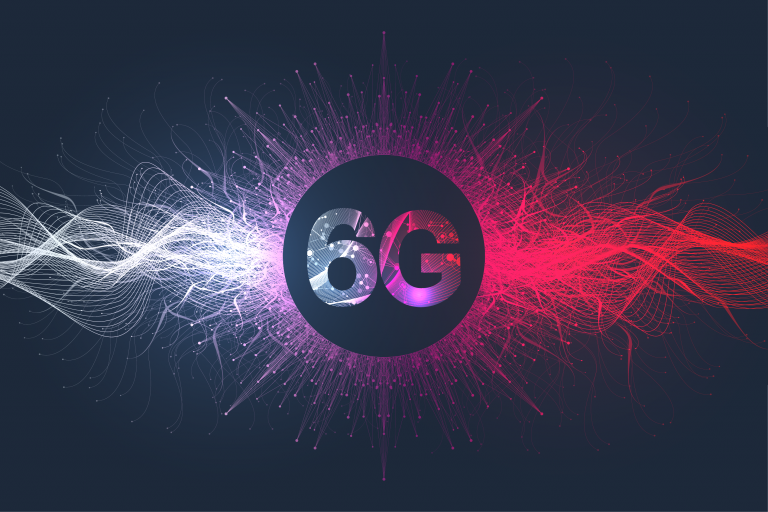
Key Points
- In its work to develop 6G, the industry has new opportunities to reconsider the service and design requirements of seamless connectivity and convergence.
- Careful consideration of this next generation of mobile technologies will result in more efficient and simplified integration of the wireline and mobile industries.
- The first specifications of 5G Advanced, which will bridge the evolution from 5G to 6G, are expected this year.
Every decade, a new generation of mobile technologies, known as “G,” is developed, along with its own set of capabilities. Recently, the ITU Radiocommunication Sector (ITU-R) unveiled its IMT-2030/6G vision, which outlines capabilities of the 6G network built on top of its earlier IMT-2020/5G vision. The initial standards for the IMT-2030/6G vision are expected to be available around 2029.
The initial release of 5G became available around 2018. Although the 5G buildout is still in progress, the industry has already started discussing 6G. The 3rd Generation Partnership Project (3GPP) decided that Release 21 would be the first release of its 6G specification work. The exact schedule for Release 21 is still under consideration, but 3GPP is looking to hold a 6G workshop in March 2025, targeting the first 6G study package for approval in June 2025. This year, 3GPP will begin deliberating 6G service requirements.
So, 6G is not on the distant horizon! It’s closer than you think.
The broadband industry has been actively working toward fixed-mobile convergence and multi-access seamless connectivity in 5G design. However, the intent of incorporating such design principles may have created unforeseen complexities and introduced optional features that may have impacted commercialization timelines. Now that we have another design opportunity with 6G, we can reconsider major service/design requirements of seamless connectivity and convergence so that 6G design considers those from the start and incorporates them as integral components to the 6G architecture.
The use cases and capabilities we can expect from 6G are shown in the graphics below.
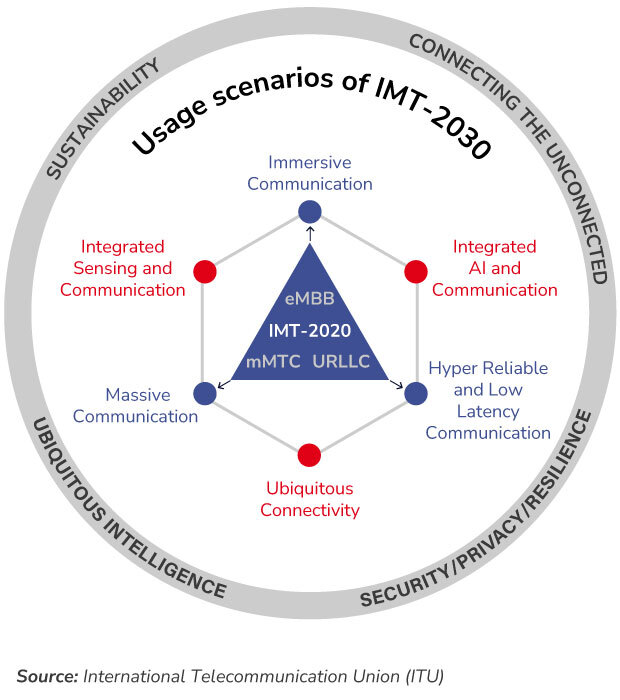
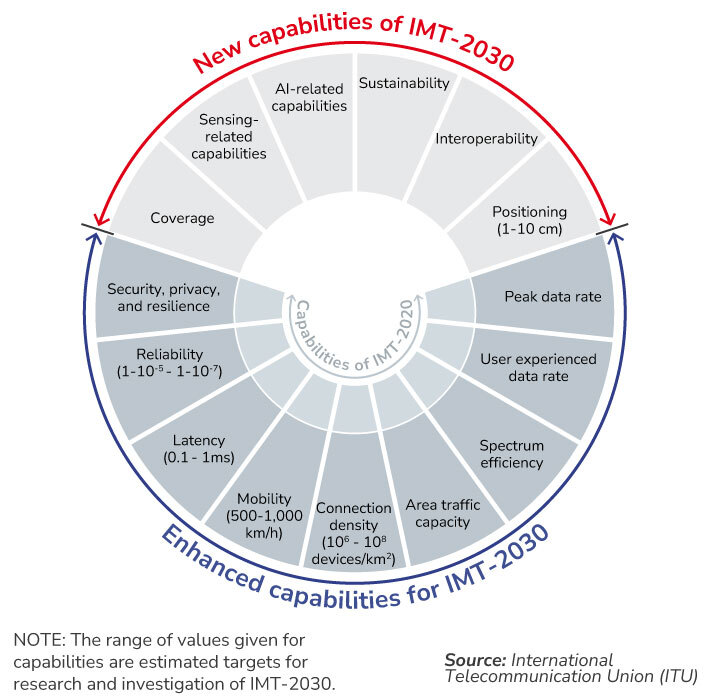
The Path to 6G
Understanding the mobile technology trends that are leading to 6G provides an opportunity to successfully integrate broadband industry requirements into the 6G architecture and design. Today, 3GPP is actively working on developing 5G Advanced, with certain features expected to bridge the evolution from 5G to 6G. The first specifications of 5G Advanced (Release 18) are expected in early 2024.
Some of the new 5G Advanced features include support for artificial intelligence (AI) and machine learning (ML), tighter integration between terrestrial networks (TNs) and non-terrestrial networks (NTNs), and improvements related to energy efficiency.
An example roadmap of 5G–6G, shown below, groups the new features into three categories: System Enhancements, Diverse Consumer Device Support and Different Radio Access Technology/Vertical Integration. The features will figure heavily into groups of projects, improving core performance, extending coverage of device types and expanding vertical sectors that incorporate mobile technology.
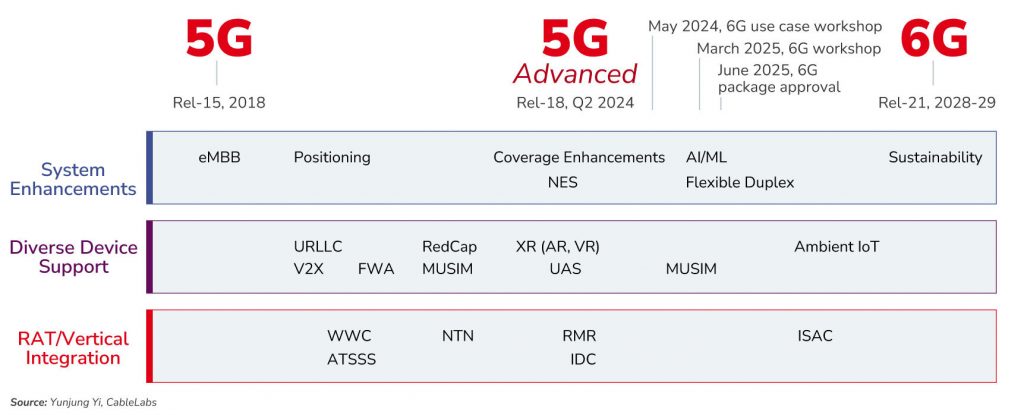
Here are a few examples of features in each category:
- System Enhancements. In each release, one or more features have been proposed and worked on to improve 5G system performance in consideration of various key performance indicators (KPIs). For example, 5G Advanced proposes positioning enhancements, coverage enhancements, AI/ML-based optimization for air interface/Next Generation Radio Access Network (NG-RAN), Flexible Duplex to address the uplink latency issue of Time Division Duplexing (TDD), and Network Energy Savings (NES). In 6G, we’ll see support for new advanced capabilities in the areas of sustainability, coverage, pervasive AI, interoperability and positioning.
- Diverse Consumer Device Support. One of the key differences between 5G and 4G is that 5G supports various consumer devices and diverse vertical markets. For example, Ultra-Reliable Low Latency Communications (URLLC) supports Industrial IoT devices such as robotics, machinery, automation, sensors and controllers. Vehicle-to-everything (V2X) technology supports vehicle, pedestrian and device-to-device communication between smartphones, wearables and drones. Reduced Capability (RedCap) devices support 5G connectivity with limited capabilities (e.g., lower data rate, bandwidth support) compared with normal smartphones. Fixed Wireless Access (FWA) supports a home gateway offering broadband services to home/customer premises. Multi-SIM capability supports the enhancement of devices with more than single-subscription information. Unmanned Aerial Systems (UAS) technology supports high-altitude aircrafts/airplanes. Extended Reality (XR) supports XR glasses, augmented reality (AR) devices and virtual reality (VR) devices; in fact, XR enhances the 5G network and RAN to support lower latency and more importantly lower jitter for multimedia. Moreover, 5G promises to extend its support for ambient IoT devices to the point at which ambient IoT device types will further reduce complexity compared with 4G Advanced’s Narrowband IoT (NB-IoT) support. In 5G and later, a device type considered in ambient IoT might have similar capability to Radio Frequency Identification (RFID).
- Different Radio Access Technology/Vertical Integration. The 5G standard also supports integrated/converged networking to various radio access technologies (RATs) and/or vertical sectors. For example, 5G supports integration with Wi-Fi networks — e.g., in-device coexistence (IDC) — to better manage resources, New Radio Unlicensed (NR-U) and Wi-Fi coexistence with mobile access. The 5G standard also supports fixed-mobile convergence architecture — for example, Wireless-Wireline Convergence (WWC). Moreover, starting in Release 17, satellite-based New Radio (NR) technology has been a key aspect of 3GPP in the form of NTNs. Recently, 5G Advanced has begun to investigate Integrated Sensing and Communications (ISAC) so that the first ISAC specification may be available in the Release 20 timeframe. Access Traffic Steering, Switching & Splitting (ATSSS) provides user data support over multi-access computing. Finally, Railway Mobile Radio (RMR) supports railway communication.
Mobile communications based on 5G/6G have devoted significant energy toward providing certain quality of service (QoS) levels to customer devices. In Release 19, 3GPP plans to further identify various users/devices sharing a subscription — say, 5G user equipment (5G UE) or 5G residential gateway (5G-RG) — and provide differentiated QoS to each user/device.
The graphic below illustrates various customer devices/device categories that the 5G/5G Advanced system supports — spanning various quality metrics and KPIs. For example, XR devices for AR/VR require very low latency (e.g., 1 ms) while handling high data rate demand (e.g., 100 Mbps – 1 Gbps). At the same time, due to the form-factor limitations of some XR glasses/equipment, a number of receiver antennas for a device may be limited as a result of required coverage enhancements compared with normal 5G UEs. In another example, reduced-capability devices will further decrease the number of receiver antennas and supported bandwidth (and thus require more coverage enhancement) but will offer improved energy-saving features (e.g., longer sleep) while relaxing QoS requirements. In 5G, more devices with higher capabilities (e.g., higher power, higher number of transmission/reception antennas) will support various verticals such as NTN, railway, aerial, fixed wireless gateway and so on.
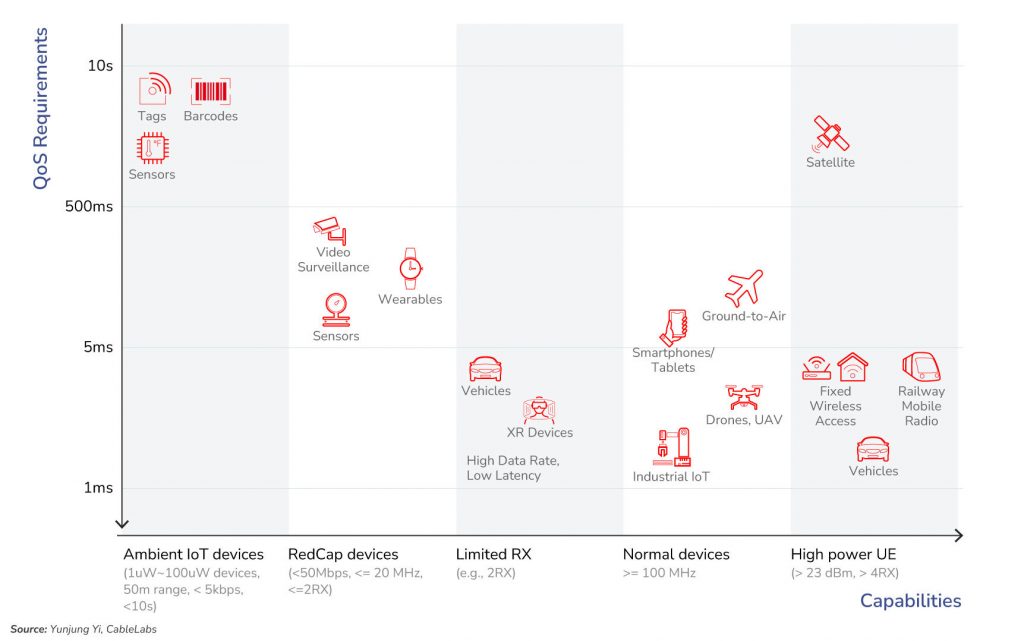
Support for a large variety of customer devices in a single system has both benefits and drawbacks. For example, 5G adopts the concept of network slicing to potentially alleviate some drawbacks in which each slice with partitioned resource/management supported different devices or verticals.
It is evident that mobile industry aims to expand its coverage to various industry sectors where the broadband industry currently holds sway. One consideration is to support broadband operation via FWA or NR-based NTN — at least, in some areas where fixed broadband may not be easily achievable. Another example is to support various sensors, video surveillance systems and home devices that have traditionally been supported by home Wi-Fi. The 5G/5G Advanced system not only supports various device types but also various spectrum/frequency options, such as unlicensed spectrum, lightly shared spectrum (e.g., CBRS band), licensed spectrum and satellite spectrum.
How 6G Matters to the Broadband Industry
Based on a recent technical report from ITU-R, 6G will reach for more integrated, highly automated and intelligent infrastructure that contains several operational domains in various types of network segments (e.g., wired/wireless access, core, edge and space segments). In the 6G network, an operator may potentially target a service provider offering an end-to-end system — that is, from application to customer, including transport.
Broadband industry operators might become connectivity operators, providing transport (or any segment of the 6G system), or service providers responsible for the entire end-to-end system. Either way, understanding 6G requirements and the trends of the mobile industry will be important to consider:
- The QoS management framework can be enhanced to support traffic requirements between various end customer devices and diverging end applications. For example, Packet Delay Budget (PDB) or Packet Data Unit (PDU) Set Delay Budget (PSDB) — for packets with inherent dependency on one another — may be supported in fixed networks to accommodate end-to-end delay requirements. Another example could be to extend network slicing or virtual/physical resource partitioning to support certain vertical applications or diverse QoS requirements.
- Identification and management of the end customer (e.g., user, application, device) can be enhanced to customize capabilities, necessary QoS requirements of the end customer and the corresponding cable network management/control plane. For example, subscription models of the cable network can be enhanced (e.g., via fixed-mobile convergence) to address the needs of certain end customers/devices/applications.
- The cable access network can be offered as a Transport as a Service (TaaS) option that can be integrated with various management/core networks. For example, the Service-Based Architecture (SBA) between 6G core network and various access networks — including cable access and mobile radio access — may be designed such that the 6G core can connect to cable access without requiring complicated gateway functionalities such as the Wireline Access Gateway Function (W-AGF). Further disaggregation of cable network functions could allow for flexible network topologies.
- To support sustainability, 6G design must transcend individual RAT energy-saving measures and adopt a holistic approach that includes cross-RAT/multi-access energy-saving features while providing a seamless user experience.
As noted, 6G is coming sooner rather than later.
Now is the perfect time to review lessons learned from the 4G and 5G experiences on multi-access integration (e.g., Wi-Fi interworking, WWC) and carefully consider 6G design choices and requirements from the beginning. Doing so will result in more efficient and simplified integration of the wireline and mobile industries, and will enable coverage of various industry sectors through integrated/automated converged mobile/wireline access networks.
If you would like to be a part of the discussion around 6G specification activity, contact me using the button below.

Wireless
Building a Smarter 5G Future Through Open RAN Development
Technological advancements are paving the way for flexible, cost-efficient and scalable solutions that will transform our digital lives. For the mobile industry, this means helping revolutionize the telecommunications landscape by harnessing the capabilities of 5G to redefine connectivity. This fifth generation of cellular wireless network technology is delivering faster speeds and will soon deliver lower latency — enabling powerful, cutting-edge applications and Internet of Things devices.
But to fully realize 5G’s potential, the network infrastructure behind it requires modernization. Operators often are limited by the hardware and software used in cellular networks. Traditional radio access networks (RANs) lock an operator into a single equipment supplier’s technology, leading to higher costs and less innovation in the industry.
Open RAN, by contrast, opens up possibilities for the infrastructure. It enables equipment interoperability to drive innovation, reduce costs and create more resilient, reliable and secure networks — big advantages for both the industry and end users.
CableLabs recently wrapped up a day packed with insightful discussions about Open RAN — what it is, where it’s going and how we’ll realize its potential. The presentations and conversations took place at SCTE Cable-Tec Expo 2023. Speakers and panelists during Expo’s Open RAN Technical Summit included industry analysts and experts from some of the world’s leading mobile operators and equipment vendors. We also heard from CableLabs’ own experts as well as representatives from government Open RAN programs in the United States and the United Kingdom.
Why Open RAN?
Before I dive into some of the highlights from the Technical Summit sessions, you might be wondering: Why is CableLabs — a company founded to advance cable technology collaboration and innovation — focusing on a wireless architecture like Open RAN?
The answer is simple: It mirrors the priorities of our members. More than half of CableLabs member companies also offer mobile services, and finding solutions for future 5G networks is high on their list. For these mobile network operators (MNOs) to successfully navigate the path toward the wireless networks of the future, they’ll require a robust and open ecosystem.
The development of the open architecture is in its early stages, and — as several speakers during the Technical Summit noted — we’ll start to see the fruits of our collective labor pay off in the next few years. Below are other key takeaways from the speakers and panelists in the operator, vendor and government sessions during the Open RAN Technical Summit event.
Operator Deployments and Planning
MNOs around the world are working on solutions for more flexible and cost-effective networks. To enhance their 5G network capabilities, operators actively collaborate with solution providers and help lead conversations in the industry to foster innovation and accelerate the development and deployment of Open RAN. Here’s a look at a few of the topics discussed during the Technical Summit’s sessions with operators:
A key topic and initiative. MNOs originated the work on Open RAN many years ago to tackle the key points noted above, and their interest continues. Earlier this year, a coalition of European operators — Deutsche Telekom, Orange, Telecom Italia (TIM), Telefónica and Vodafone — published their latest report on the state of the ecosystem, “Open RAN MoU Progress Update on Maturity, Security and Energy Efficiency.”
Ramping up deployments and commitments. Operators at the forefront of Open RAN deployment include Vodafone, which has committed to 30 percent of its sites deploying Open RAN throughout Europe by the year 2030. Also, Dish Networks has deployed Open RAN across its greenfield network in the U.S. over the last couple of years.
Ongoing research and development. Not all MNOs are actively deploying Open RAN, but all are researching, testing, trialing or involved in other similar activities. Some operators just finished deploying their 5G networks using traditional RAN networks and vendors, but they are already working to understand when the time will be right to start deploying Open RAN.
Suppliers Partnering for Innovation
As the industry moves toward more open and modular RAN architectures, vendors aren’t just contributors to the development; they’re also key drivers of innovation. Their solutions must meet the demands for security, efficiency and sustainability to enable the next generation of wireless networks. Solution providers around the world are involved in advancing Open RAN innovations, and, during the summit, we heard from a few of these traditional vendors and newer suppliers. Here’s a glance at what was discussed in the sessions:
Commitments from leading suppliers. Ericsson announced in September and restated in partnership with Vodafone its support and plans for Open RAN at the Telecom Infra Project (TIP) Fyuz Conference in Madrid in October. They further confirmed this and additional details about their plans at Cable-Tec Expo.
Multi-supplier networks: Nokia has also recently made commitments to support the Open RAN ecosystem with its solutions and announced deployments with Docomo in Asia. The company also recently announced a partnership with Mavenir to “prove Open RAN system performance.”
Interoperability activities. Mavenir and other newer vendors that have focused on Open RAN have been active in interoperability activities and events like the 5G Challenge and O-RAN Open Test and Integration Center (OTIC) PlugFests for a number of years already.
A Boost at the Government Level
Open RAN development hasn’t been limited to industry players. With its promise to make networks more open, flexible and inclusive, it’s no surprise that governments around the world are taking note. This significant investment of capital and resources at the government level will result in a more diverse and competitive marketplace, a more resilient and secure supply chain, and improved national security. The summit highlighted the work in this sphere, including:
Government strategy. Agencies such as the National Telecommunications and Information Administration’s (NTIA’s) Institute for Telecommunication Sciences (ITS) in the U.S. and the U.K.’s Department for Science, Innovation and Technology (DSIT) are heavily invested in jumpstarting the development and eventual deployment of products for 5G networks. Other governments that are investing in the development of the ecosystem include Canada, Germany, Australia, India, South Korea and Singapore.
Active participation and promotion. Activities such as the recent 5G Challenge — for which CableLabs served as the host lab — and the U.K.’s similar Future RAN Competition (FRANC) are designed to foster collaboration and accelerate commercial adoption of Open RAN solutions.
Accelerating Adoption Through Activities
These important discussions during the Open RAN Technical Summit only scratch the surface of the work that CableLabs and others are doing to develop interoperable solutions that will advance 5G networks. Involvement in PlugFests and events like the 5G Challenge — as well as industry working groups, field trials and ongoing standards work with the O-RAN Alliance — place operators, vendors and government agencies chief among the experts at the forefront of developing Open RAN solutions.
CableLabs’ involvement in this area isn’t new, and our commitment to Open RAN is only growing stronger. My recent participation this month on a panel at the Joint O-RAN Software Community (OSC)/Open Source Focus Group (OSFG) and OpenAirInterface (OAI) Workshop is another recent example of how our Wireless Technologies team continually keeps these conversations going with other stakeholders.
Our work continues, along with our involvement in 3GPP, O-RAN Alliance and TIP. Together, we’ll move the industry toward our mutual goal of a fully interoperable, virtual, multivendor 5G network. To stay up to date on CableLabs’ work in Open RAN and other mobile technology areas, click the button below to subscribe to our blog.

Wireless
2023 5G Challenge Event Closes Chapter on Open RAN Competition
The 5G Challenge culminated in an inspiring event September 21 with the awarding of $7 million in cash and in-kind prizes to providers of high-performing Open Radio Access Network (RAN) solutions. CableLabs, which served as the host lab in partnership with subsidiary Kyrio, welcomed U.S. and international stakeholders to our headquarters in Colorado for a ceremony marking the end of both the 2023 competition and the two-year challenge program.
Open RAN — a next-generation wireless network architecture — makes building, expanding, upgrading and repairing networks simpler and cheaper for mobile network operators (MNOs). More than half of CableLabs’ member companies are MNOs.
The 5G Challenge was launched in 2022 as a collaboration between the National Telecommunications and Information Administration’s Institute for Telecommunications Sciences (NTIA-ITS) and the Department of Defense (DoD). The objective was to accelerate the widespread adoption of 5G open interfaces, interoperable subsystems, secure networks and multivendor solutions by cultivating a thriving and vibrant vendor community. We share the NTIA and DoD’s goals for creating a more competitive and diverse Open RAN ecosystem.
What Is Open RAN?
Open RAN enables mobile service providers to use subcomponents from various vendors in their wireless networks. Traditional RAN, by contrast, uses a single vendor for all its components, which limits innovation and raises costs. By avoiding vendor lock-in, mobile service providers can repair and replace RAN components and software more quickly and efficiently, which ultimately reduces the cost of deployment and overall lifecycle costs.
Collaboration at Every Level
Selected as the host lab for both years of the challenge, CableLabs partnered with Kyrio — the first O-RAN Alliance Open Testing and Integration Center (OTIC) in the Americas — to provide expertise and our facility for testing the contestants’ systems. The testing of components by an independent and neutral lab is key to the Open RAN ecosystem.
Watch the video below to take a look at our state-of-the-art lab and our expert staff working on Open RAN.

CableLabs’ ongoing involvement in Open RAN activities, including hosting O-RAN Alliance PlugFests, and our extensive expertise in mobile network technologies made our facilities well suited for meeting the goals of the challenge. Our staff also assisted the NTIA-ITS and DoD in designing the challenge, including the rules and grading process.
Nine contestants were selected for the 2023 5G Challenge, and solutions were judged for their ability to demonstrate multivendor interoperability across radio units (RUs) and combined central units (CUs) and distributed units (DUs).
“Working together as an industry, working together across the vendor community and with the support of NTIA and our other partners, we were able to do that in a very short timeframe — all of five weeks,” our president and CEO, Phil McKinney, noted during the closing ceremony. “Many people didn’t think it could be done, but it got done.”
Colorado Gov. Jared Polis was also among the government officials, policymakers, industry leaders and other experts attending the event at CableLabs’ Louisville headquarters. He commended the 2023 contestants’ spirit of innovation and touted the impact of the industry.
“I always find that these challenges really bring out the best of us,” he said. “Rather than just doing more of the same, we’re challenging people and companies to do things in new and different ways. And one thing’s for sure: The better connected we are to one another, the stronger our communities are and the stronger our economy will be. That’s really, at its core, what 5G technology is all about.”
The 5G Challenge Winners
CableLabs congratulates Lions, Mavenir, NewEdge and Radisys, which comprised the team winning the largest of the 2023 5G Challenge total prize purse awards — $3 million — in the “Stage Four: Mobility” category. The winning team and another mobility team — Capgemini, JMA Wireless and QCT/Benetel — both successfully completed Stage Four, and a tiebreaker determined the prize winner. Other winners were:
Multivendor End-to-End Integration Prizes
- First place ($750,000 each and additional lab time): Capgemini and QCT/Benetel
- Second place ($250,000 each): Lions and Radisys
Wrap-Around Emulation Prizes ($100,000 each)
- Capgemini (CU+DU)
- Fujitsu (RU)
- GXC (CU+DU and RU)
- JMA Wireless (CU+DU)
- Lions (RU)
- Mavenir (CU+DU)
- NewEdge (RU)
- QCT/Benetel (RU)
- Radisys (CU+DU)
Best in Show Prizes
- Best Software Bill of Materials (SBOM) and Vulnerability Exploitability eXchange (VEX) ($100,000 each and security testing): Fujitsu and JMA Wireless
- Best Collaborator ($20,000 and security testing): Lions
The participants successfully demonstrated end-to-end data sessions across an Open RAN architecture with multiple vendors. They also demonstrated multivendor end-to-end interoperability with three pairs of Open RAN subsystems conducting data sessions using various protocols, traffic loading and stability in varying radio frequency (RF) conditions. And, in an industry first, mobile handover between two separate multivendor Open RAN next-generation node Bs (gNBs) was achieved.
CableLabs looks forward to working with contestants that were also awarded additional lab time or security testing.
Last year, the 2022 5G Challenge offered a $3 million prize purse to contestants that successfully integrated hardware and/or software solutions for one or more RU, CU and/or DU subsystems.
Building on Successes Together
There's still more to do to fully develop the Open RAN ecosystem, and a neutral lab like ours will be essential for efficient and effective testing. CableLabs is committed to the growth of Open RAN infrastructure, and we look forward to future collaborations with the NTIA and DoD.
Together, we can build a more open and truly plug-and-play Open RAN ecosystem.

Wireless
Wi-Fi 7 To Transform the Online User Experience

Wi-Fi continues to be the world’s preferred wireless technology, with a record 19.5 billion devices expected to be in use by the end of this year. Many factors have contributed to the widespread adoption and success of Wi-Fi technology, including its support for mobility and its ubiquity due to operation in unlicensed bands and relatively low-cost deployment.
Over the years, Wi-Fi has evolved to support new applications and innovative use cases as technology has shifted toward digitization. Today, users expect more from their Wi-Fi than ever before at home, in the workplace and at school. As the demand for higher data rates and capacity continues to rise, latency and reliability have become key performance indicators to support applications such as online gaming, video conferencing and augmented reality (AR)/virtual reality (VR).
Wi-Fi is based on amendments to the IEEE 802.11 standard. The IEEE 802.11 amendments regularly introduce new features to deliver higher throughput and capacity, increase spectrum efficiency, and lower latency and power consumption. The most recent Wi-Fi generation, Wi-Fi 6 (based on IEEE 802.11ax), was launched by Wi-Fi Alliance (WFA) in 2018 for operation in the 2.4 and 5 GHz bands, and Wi-Fi 6E was launched in early 2021 for operation on the 6 GHz band. Wi-Fi 6/6E has strong market adoption, and WFA is now preparing the next generation of Wi-Fi — Wi-Fi 7 — to support ever-evolving applications and use cases.
Speed, Capacity, Latency and Reliability
The WFA Wi-Fi 7 certification is based on the IEEE 802.11be amendment called Extremely High Throughput (EHT), which operates on 2.4, 5 and 6 GHz bands. The 802.11be amendment increases throughput due to the larger 320 MHz bandwidth available at 6 GHz and 4K quadrature amplitude modulation (QAM). Devices such as laptops are expected to reach speeds up to 5 Gbps in optimal wireless conditions.
One of the unique key features of 802.11be is the multi-link operation (MLO), which allows for simultaneous connections to different bands. On top of higher throughput due to link aggregation, MLO improves reliability, enhances band steering and load balancing, and reduces latency. Latency-sensitive applications and applications that require more deterministic connectivity are also supported thanks to the stream classification service (SCS) feature. The amendment also addresses spectrum efficiency and interference mitigation thanks to features such as multi-resource units (M-RUs) and preamble puncture.
Wi-Fi 7 is already gaining momentum, and many manufacturers — including original equipment manufacturers (OEMs) — have announced the availability of chipsets and solutions. The Wireless Broadband Alliance (WBA) has just released a report that explores how Wi-Fi 7 will transform the way people worldwide live, work, learn and play. The report is available as a free download from the WBA.
Preparing for the Next Generation of Wi-Fi
While WFA focuses on developing Wi-Fi 7 certification to ensure product interoperability, IEEE 802.11 is initiating the development of the next IEEE 802.11 amendment, known as 802.11bn (likely to be marketed as Wi-Fi 8). It typically takes several years to complete 802.11 amendments, and the finalization of 802.11bn isn’t expected before 2027 or 2028.
IEEE 802.11bn will focus on reliability, including increasing throughput at range, reducing tail latency and supporting seamless/near-seamless roaming/mobility. It will also provide schemes to reduce access point (AP) power consumption as regulators around the globe address customer premises equipment (CPE) power consumption.
How is CableLabs working to support these efforts? As part of our ongoing mission to represent the interests of our members, we take part in many WFA and IEEE 802.11 working groups to shape the future of Wi-Fi.
We also actively participate in the WBA, which fosters collaboration and promotes the development of wireless broadband technologies and services. Together with other industry leaders, we’re working to develop a Wi-Fi infrastructure that can support the development of future technology, meet expanding user needs and deliver great user experiences.
Visit our website to learn how we’re supporting these initiatives in our Wi-Fi Lab.

Wireless
Bringing Open RAN Closer to Broader Adoption: Insights from the Spring ’23 O-RAN PlugFest at CableLabs

Open Radio Access Network (Open RAN) is one of the most talked-about mobile network technologies these days — and for good reason. There’s a need to reshape the mobile industry toward fully interoperable, secure, trustworthy and cost-effective networks.
Recognizing that need, governments are beginning to throw their support behind the technology. In May, leaders in the Quadrilateral Security Dialogue (commonly known as the Quad) announced cooperation with Palau to deploy Open RAN, the first deployment of its kind in the Pacific Islands. In June, the governments of the United States and India announced that they would partner on Open RAN field trials and rollouts, including scaled deployments.
But those interoperable network architectures aren’t built overnight. First, their technical specifications need to be agreed upon. Then, their implementation needs to be tested before the network architectures can become commercially available.
Spring 2023 O-RAN Global PlugFest
Twice a year, a worldwide community of vendors, operators, and research and academic institutions gathers to test their latest O-RAN implementation during O-RAN Global PlugFest events. CableLabs, which has been active in O-RAN Alliance work groups for some time, started hosting PlugFests in 2022, participating in the most recent event this past spring.
The Kyrio O-RAN Test and Integration Center (OTIC) at CableLabs was one of four North American host labs for the Spring 2023 PlugFest. The event brought innovation to the cost-efficient operation and management of Open RAN while also expanding the vendor ecosystem.
Tackling Challenges
Multi-Cloud Enabler
If a telecom operator needs to manage cloud workloads at various locations (i.e., edge, core) while maintaining the freedom to choose between cloud providers and vendors, a standardized, cost-effective approach is necessary. Open RAN addresses that need by specifying the O2 interface, which connects the service management and orchestration (SMO) platform to the Open RAN Cloud infrastructure (O-Cloud). More specifically, the management of the cloud infrastructure (i.e., compute, hardware accelerator, storage, gateway and site network fabric) is performed via the O2-infrastructure managed services (O2-IMS) interface.
In April, the Cloudification and Orchestration Work Group (WG6) drafted the first version of the O2-IMS Conformance test specification, aiming to ensure compatibility and interoperability among different implementations. At this PlugFest, O2-IMS Conformance testing on Red Hat OpenShift O-Cloud was demonstrated for the first time. Although the conformance of the O2-IMS implementation was successfully validated, the testing also revealed areas for improvement in the specification, which were fed back to the standards. In addition, to make O2-IMS conformance testing widely available, the RobotFramework test scripts developed by Red Hat will be submitted to the O-RAN Software Community Infrastructure (SC INF) open-source project.
Energy Savings Toward OpEx Reduction
GSMA, an industry organization representing the interests of mobile network operators worldwide, indicates that energy consumption typically accounts for 15 percent to 40 percent of operators' operating expenses (OpEx). This percentage is forecasted to increase in the coming years, following the mobile data traffic growth trajectory. That makes energy savings extremely important for operators. Some may turn off equipment during off-peak hours to conserve energy, but they must still maintain quality of service (QoS). Thanks to recent advancements in machine learning (ML) and Open RAN architecture implementation — for example, rApps running on Radio Interface Controller (RIC) — that job can become more efficient.
During the PlugFest, we observed the Capgemini AI/ML-powered energy savings (ES) rApp to ingest performance measurements and configuration management data generated by the VIAVI RIC Test/AI training module via the standard O1 and R1 interfaces. The data was used to train the rApp ML algorithm to predict the sector and cell load accurately. The ML prediction enabled the ES rApp to identify and timely schedule energy savings measures for the target cells while maintaining subscribers’ QoS.
Ecosystem Expansion
Despite the progress made toward improving the operational efficiency of Open RAN, a large and vibrant vendor ecosystem still remains a prerequisite for its broad adoption. Effnet, a new entrant to the ecosystem, brought its system combining Distributed Unit (DU), Central Unit (CU) and 5G Core Network (5GCN) entities for first-time integration and testing with VIAVI user equipment (UE) and radio unit (RU) emulators. These components formed an end-to-end system under evaluation. We observed the open fronthaul being successfully integrated using distributed network timing (LLS-C3) topology. In addition, cell broadcast was verified and 5G New Radio (NR) initial access was tested. This was one more testament that equipment from a new vendor, which interprets the open standards correctly, can interoperate via open interfaces. More importantly, the knowledge obtained will be applied at the next PlugFest in Fall 2023.
Read more about recent O-RAN Global PlugFest events, and look out for more information about the Spring 2023 event.
Other Important Open RAN Initiatives
Our involvement with O-RAN Global PlugFest events is just one way CableLabs and its subsidiary, Kyrio, partner with the industry in the development of interoperable and cost-efficient network technologies.
For a second consecutive year, CableLabs and Kyrio are hosting the 5G Challenge, which recognizes high-performing Open RAN solutions that demonstrate multi-vendor interoperability across radio, centralized and distributed units.
Also, for vendors seeking to certify their Open RAN equipment, Kyrio offers certification and badging testing services.
What’s Next for Open RAN?
The spring PlugFest event fostered innovation, identified areas for improvement and expanded the Open RAN ecosystem. But our work doesn’t end there. For Open RAN to become the radio access network architecture of choice, it must demonstrate efficiencies that surpass the monolithic RAN it aims to replace. Herein lies the challenge: How can an open and distributed network architecture, like Open RAN, generate cost savings that make its deployment worthy?
We’ll explore answers to that question and put them to the test in future O-RAN PlugFests at our Kyrio OTIC.
If you’re a CableLabs member, vendor or developer with a solution or an idea to reduce the cost of deploying and operating Open RAN, contact us using the button below.

Wireless
Raising the Bar for Open-Source Wi-Fi: TIP OpenWiFi Release 2.9 Validated

This week, CableLabs and the Telecom Infra Project (TIP), a global community of companies and organizations committed to developing improved infrastructure solutions for the Wi-Fi ecosystem, announced the successful validation of TIP OpenWiFi Release 2.9. CableLabs has also commissioned a refreshed OpenWiFi Community Lab to serve as a testing ground and demonstration stage for global cable operators.
TIP OpenWiFi is an open-source, community-developed, disaggregated Wi-Fi hardware and software system. As the cable industry seeks to accelerate Wi-Fi innovation and improved connectivity, this critical initiative supports the need for better networks and the growing adoption of Wi-Fi 6 devices across various applications.
Since OpenWiFi was launched in May 2021, CableLabs has supported the initiative with ongoing collaboration and R&D. This week’s announcement represents a new milestone in the pursuit of plug-and-play interoperability and moves the industry closer to the future of Wi-Fi.
Empowering Advanced Connectivity
TIP OpenWiFi is designed to lower the cost of developing and operating managed Wi-Fi networks, encourage suppliers and service providers to collaborate on development and integration, and improve choice and flexibility in Wi-Fi infrastructure.
As ecosystem stakeholders develop enterprise-grade Wi-Fi solutions, OpenWiFi creates strategic value by:
- Introducing diversity in the supply chain. With OpenWiFi, there’s no shortage of products because suppliers aren’t limited to one country, company or manufacturer.
- Eliminating vendor lock. By promoting openness in the Wi-Fi ecosystem, OpenWiFi makes it possible to mix and match products and suppliers to suit the specific needs of the Wi-Fi network.
With the launch of Release 2.9, OpenWiFi empowers advanced connectivity by supporting OpenRoaming, a roaming federation service from the Wireless Broadband Alliance that enables an automatic, secure global Wi-Fi experience. The new version is built on the uCentral communication layer and supports Multi Pre-Shared Key (MPSK), allowing devices to log in based on MAC address. It also supports a captive portal to require user interaction before they are granted Wi-Fi access.
“When OpenWiFi works seamlessly with OpenRoaming out of the box, it creates strategic business opportunities in verticals including retail, hospitality, education and multi-dwelling units,” said Tiago Rodriques, CEO of the Wireless Broadband Alliance. “It’s a smart move by the community developing and building the OpenWiFi solution to include OpenRoaming capabilities.”
Working Together to Accelerate Wi-Fi Innovation
In the brief time since OpenWiFi launched, there has been significant adoption by partners including NetExperience, VVDN Technologies, ActionTec and Edgecore Networks, as well as new global managed service providers (MSPs) and multiple-system operators (MSOs). Commercial deployments have seen success in the United States with Boingo Wireless, in India with Spectra, in Pakistan with Multinet, in Kenya with ThinkWiFi and Mawingu, and a trial with the City of Dublin and Virgin Media that complies with the European Commission’s WiFi4EU initiative, the benchmark for public Wi-Fi deployments in Europe.
Under TIP, OpenWiFi is a coordinated approach to openness within the Wi-Fi ecosystem. It brings together industry stakeholders, including corporations, industry alliances and open-source communities, to accelerate innovation and development of enterprise-grade Wi-Fi solutions. The system includes a cloud controller software development kit (SDK) and enterprise-grade access point (AP) firmware and is designed and validated so that these components work seamlessly together. Using standardized open APIs, the software platform allows APs to be managed from the cloud. A single codebase can be used on any compliant whitebox hardware, and developers can use the API to build innovative services on the cloud and target any device running on the OpenWiFi stack.
Test, Verify, Deploy
CableLabs’ OpenWiFi Community Lab offers CableLabs members who are building Wi-Fi networks the opportunity to demo, test, trial and ultimately deploy OpenWiFi. Companies participating in the trial and the OpenWiFi Lab include hardware manufacturers as well as software cloud controller companies: ActionTec, EdgeCore Networks, HFCL, Indio Networks, Lindsay Broadband and NetExperience.
“CableLabs has supported OpenWiFi since the launch, and we believe in the power of open and disaggregated Wi-Fi solutions,” said Josh Redmore, Principal Architect of Wireless Access Technologies for CableLabs. “This new version of OpenWiFi leverages open-source software and hardware to greatly reduce the barrier to entry of deploying managed Wi-Fi.”
Ongoing collaboration with TIP empowers the Wi-Fi ecosystem to center innovation and development on customer needs. As the leading innovation and R&D lab for the cable industry, CableLabs empowers research, development and testing for OpenWiFi, pointing the way toward innovations that will soon be standard in the cable industry. In collaboration with other industry stakeholders, CableLabs’ partnership with TIP aims to promote rapid development of OpenWiFi-based solutions that make possible the high-quality connectivity needed to underwrite ongoing innovation both now and in the future.
Stay up to date on TIP OpenWiFi and more by subscribing to our blog and visiting our Wi-Fi lab.

Wireless
NTIA Announces 2023 5G Challenge Contestants
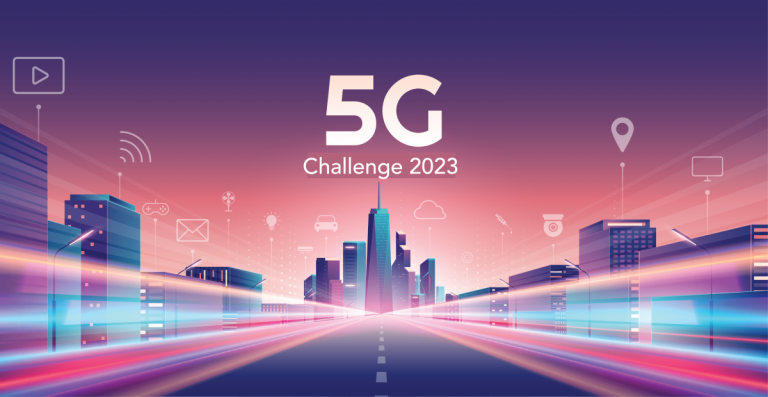
CableLabs congratulates Capgemini, Fujitsu, GXC, Lions Technology, Mavenir, NewEdge Signal Systems and Radisys for being selected as contestants in the National Telecommunications and Information Administration’s (NTIA) and Department of Defense's 5G Challenge. The competition is hosted by CableLabs, and contestants will compete for up to $7 million in cash and in-kind prizes. This group of participants was selected for their commitment and contributions to developing open and interoperable networks in the 5G ecosystem.
Like the 2022 5G Challenge, this year’s challenge will focus on testing interfaces among the Open RAN-specified subsystems and end-to-end integration, as well as testing handovers between different vendors. The Challenge seeks to accelerate adoption of 5G open interfaces, interoperable subsystems and multi-vendor solutions by:
- Utilizing existing standards for new providers
- Encouraging modular product development
- Reducing barriers to entry for new solution providers
- Leveraging industry trends
- Demonstrating multi vendor interoperability.
Awards will go to high-performing Open RAN solutions that showcase multi-vendor interoperability across radio, centralized and distributed units.
5G Challenge Host Lab Offers Cutting Edge Capabilities
For the second consecutive year, CableLabs will partner with its subsidiary Kyrio, the first O-RAN Alliance Open Testing and Integration Center (OTIC) in the Americas, to host the 5G Challenge. Our state-of-the-art 5G lab deploys fully virtualized 5G networks and mobile network technology expertise to ensure that testing meets NTIA/ITS’s goals with reliable, secure testing to industry standards.
As the host lab, CableLabs will perform wraparound emulation testing on each contestant subsystem individually and then end-to-end multi-vendor interoperability and performance testing. We’re including state-of-the-art testing systems from both Keysight and VIAVI to support the goals of the 2023 5G Challenge. Contestants will be challenged to integrate with fellow contestants’ subsystems and participate in multiple rounds of integration and performance testing—the primary thrust of this year’s challenge.
CableLabs developed the test plans in conjunction with the NTIA to focus on O-RAN Alliance and 3GPP conformance. Testing will involve multiple gNB configurations, which contain different Open RAN subsystems. The information gathered during the testing process will inform vendors, NTIA-ITS, the Department of Defense and the 5G ecosystem as a whole about the current state of the O-RAN vendor community. Stakeholders will also acquire valuable data about the benefits of interoperability and the potential for future innovations in 5G open systems and wireless networks.
As an added benefit, integration testing will include adherence to applicable O-RAN Alliance specifications. Challenge participants may receive a badge or certification from Kyrio under its OTIC lab authority.
CableLabs Technical Expertise
With our deep technical experience and wireless network expertise, CableLabs is uniquely positioned to provide support staff for the 5G Challenge. CableLabs and Kyrio staff will assist contestant teams to ensure complete and accurate testing and will provide technical analysis of each test to the NTIA-ITS.
We’re looking forward to meeting all the 2023 5G Challenge contestants at our 5G lab as we continue investing in the development of an open 5G ecosystem.


